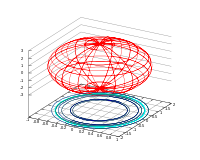

Clairaut's theorem characterizes the surface gravity on a viscous rotating ellipsoid in hydrostatic equilibrium under the action of its gravitational field and centrifugal force. It was published in 1743 by Alexis Claude Clairaut in a treatise[1] which synthesized physical and geodetic evidence that the Earth is an oblate rotational ellipsoid.[2][3] It was initially used to relate the gravity at any point on the Earth's surface to the position of that point, allowing the ellipticity of the Earth to be calculated from measurements of gravity at different latitudes. Today it has been largely supplanted by the Somigliana equation.
- ^ Théorie de la figure de la terre, tirée des principes de l'hydrostatique (Theory of the shape of the earth, drawn from the principles of hydrostatics) From the catalogue of the scientific books in the library of the Royal Society.
- ^ Wolfgang Torge (2001). Geodesy: An Introduction (3rd ed.). Walter de Gruyter. p. 10. ISBN 3-11-017072-8.
- ^ Edward John Routh (2001). A Treatise on Analytical Statics with Numerous Examples. Vol. 2. Adamant Media Corporation. p. 154. ISBN 1-4021-7320-2. A reprint of the original work published in 1908 by Cambridge University Press.